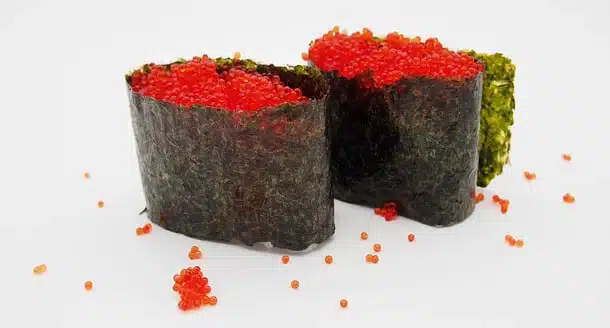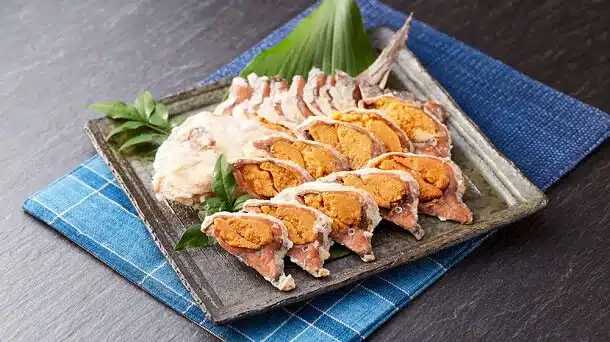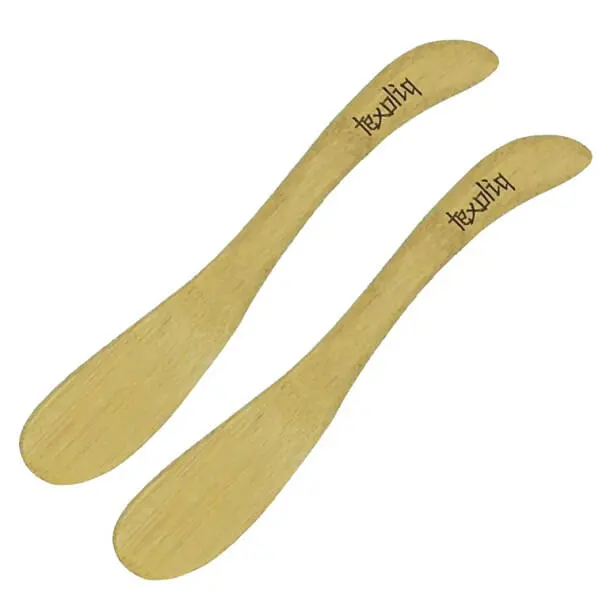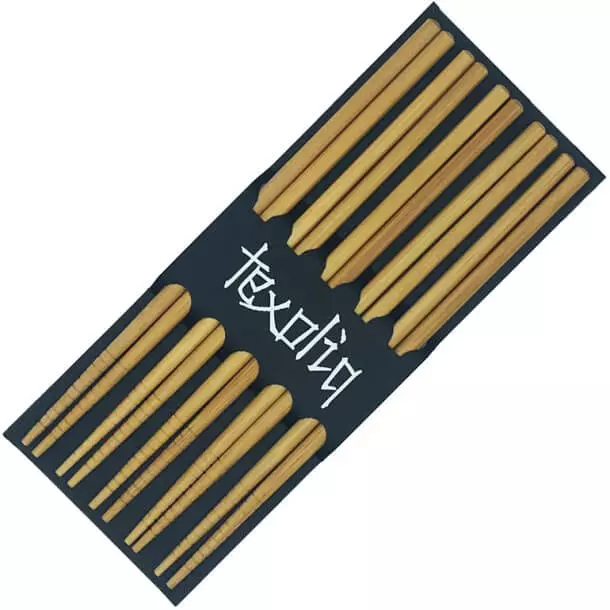
Sushi is a set of typical dishes of Japanese cuisine based on rice flavored with the basic vinegar condiment called sushizu, together with other ingredients such as raw or cooked fish, molluscs, crustaceans, eggs, vegetables, the meat and the nori seaweed. Traditionally the filling is raw and in some more innovative variants it can be found cooked and can be served in various ways (simply placed on rice, inserted in a small or large pocket of tofu, arranged in rolls, rolled up in a strip of nori seaweed). Originally sushi indicated a way to preserve fish precisely to avoid alteration, fresh fish was wrapped in fermented rice. Sushi is regarded as the main dish of Japanese cuisine.
Etymology
The term sushi means “sour”, in reference to sushizu which is the condiment used for rice, in which the taste of the vinegar, combined with sugar and salt, stands out in a particular way. More simply in Japan the word sushi means in the true sense of the word “rice seasoned with vinegar” and refers to different types of foods prepared with rice. Instead, outside of Japan it is frequently understood as raw fish or as a reference to a specific restricted genre of Japanese food, such as the various maki or even nigiri and sashimi which, unlike sushi, which has rice, is composed of only fresh fish without the use of rice.
The word sushi is transcribed with the kanji 寿司, which have been chosen for their pronunciation and not for their meaning.
History
Sushi has no Japanese origins. Someone, reading such a statement, was amazed. But it’s the truth. Sushi, a symbol of Japan and its culinary tradition, would not have been born in Japan, but in China or even Korea. The most accredited hypothesis is that it was brought, around the seventh century, by Buddhist monks returned from China. Many elements of Japanese culture, in fact, draw their origins from other nations and cultures. And that doesn’t just apply to food. Just think of bonsai, tofu or ramen, a Chinese dish that has become typical of the Rising Sun over the course of history. The same would be true for sushi, imported into Japan, modified and adapted to the tastes of its population until it becomes part of their own culture but also their lifestyle.
The first form of sushi came to Japan from China about two thousand years ago. What sushi looks like today became established around the 8th century. The fish was salted and rolled in fermented rice. Narezushi was made from gutted fish, which was placed in fermented rice for a few months to preserve it. The fermentation of the rice ensured that the fish did not spoil. When it was necessary to consume this food, the rice was eliminated and only the fish was eaten. This ancient type of sushi became an important source of protein for Japanese civilization.
Muromachi period
During the Muromachi period (1336-1573) Namanare was the most popular type of sushi. In this period, fermented rice was no longer thrown away but consumed with fish in a dish that took the name of Namanare. This dish consisted of raw fish rolled in rice, to be eaten still fresh, before it changed its flavor and texture. This new way of consuming fish was no longer due to conservation, in fact from a conservation technique, this became a real recipe appreciated by the Japanese, who soon also began to prepare it with vinegar in addition to boiled rice.
Edo period
During the Edo period (1603-1867), the ancient name of Tokyo, Japan remained almost completely isolated from the outside world. At the same time, those socio-cultural aspects that still characterize modern Japan were increasingly consolidated. In the same period haya-zushi, which literally means “fast sushi”, spread in the capital. In fact, one no longer had to wait for the rice to turn sour, but it was mixed with vinegar, fish, eggs, vegetables and dried food. However, it was still a distant relative of sushi as we know it today all over the world, nevertheless it is still very popular today.
19th century
In the 19th century, Tokyo was still known as Edo and stalls run by street caterers began to catch on. During this period nigirizushi was introduced, which consisted of a tightly stretched mound of rice covered with a slice of fresh fish. Wasabi, a spicy green paste served together with sushi, was added to cover any unpleasant flavors of the fish which, in the absence of ice, could not always be properly fresh and smell good.
20th century
In 1923, after the Great Kanto earthquake that destroyed Tokyo, the capital was the destination of millions of people, who came from all over Japan to help and rebuild the city, thus sushi began to become popular throughout the country and to expand.
In 1958, Yoshiaki Shiraishi revolutionized the way of eating sushi by introducing the Kaiten-sushi, that is the sushi conveyor belt that is still found in many sushi bars today. He had the idea during a visit to the Asahi brewery where the cans of the typical Japanese beer were transported by special belts: he thus implemented his revolutionary idea which was immediately accepted by the market, appreciated and copied throughout Japan.
In 1980, sushi landed in America: the most fashionable and fashionable places were stocked with the specialty of the moment which was immediately appreciated by yuppies, prominent personalities and VIPs of the time.
What is now internationally known as “sushi” was invented by Hanaya Yohei in present-day Tokyo. Tokyoites lived in a hurry even in the early 20th century, and this type of sushi used unfermented rice and could be eaten with the hands and/or chopsticks. It was an early form of fast food that could be eaten anywhere. It was proposed in banquets covered by a white cloth which was generally used to clean one’s hands after having finished eating, therefore a very dirty cloth was synonymous with many people eating there, therefore quality sushi!
Spread of sushi in the United Kingdom
Although it took a long time for sushi to spread in the UK, it is now enjoyed and enjoyed throughout the UK. To enjoy it at its best, it is recommended to stay away from some restaurateurs who have obviously remained behind in history and put business and profit before the quality of the ingredients and customer satisfaction, and have no respect for raw materials and preparation of this noble dish. Precisely for this reason, the TEXOLIQ brand provides guides and kits for the preparation of excellent quality sushi, so that the user can choose the ingredients independently and be sure of the origin and quality of the ingredients.
Ingredients
Sushi rice
Sushi rice is prepared with white, sweet, short-grain rice, washed and cooked following a particular preparation and then soaked in rice vinegar in which both sugar and salt are dissolved, then slightly heated, and finally kombu and sake. It is cooled to room temperature before being served and/or eaten.
The rice used is the Japonica quality which has a different consistency from those normally eaten outside Japan. The essential requirement is the good cohesion of the rice grains. If it is too sticky, the taste is overly sweet, but if it is not sticky enough, it tastes dry. Freshly harvested rice (shinmai) usually contains too much water and takes extra time to dry after being washed well.
There are regional variations in sushi rice and of course individual cooks or chefs have their own innovative methods. Most of the variations are in the vinegar dressing: the Tokyo version typically uses more salt, while the Osaka one has more sugar. In fusion cuisine restaurants, varieties of venere, wild or brown rice are used.
Sushi rice should typically be eaten shortly after being prepared to preserve its flavour.
Nori seaweed
The vegetable-type wrapping used in maki and temaki is nori seaweed, commonly nori in Japan. It is an edible seaweed traditionally grown in the ports of Japan. Initially the plants were scraped from the port poles, pressed into sheets and dried in the sun, with a procedure similar to that used for sheets of paper. Nori must be toasted before being used in foods.
Today the commercial product is grown, produced, roasted, packaged and sold in sheets of the standard rectangular size: approximately 7 inches by 8 inches. The best quality nori seaweed is thick, smooth, bright and without holes.
Omelette
To make fukusazushi, a sheet-thick omelet is used as a wrap instead of nori seaweed. The omelette is traditionally made with a rectangular pan (traditionally called a makiyakinabe) and used to form a pocket for the sushi rice and filling.
Fillings and garnishes
Often the most used filling is fish. However, fresh raw fish cannot be used, unless treated in a preventive manner with a blast chiller. Freshwater fish are among those eaten cooked. Commonly used fish are tuna, salmon, snapper, sardines and horse mackerel. The ingredient considered to be of the best quality is called toro, a fatty and marbled cut of the fattest part of the tuna, the ventresca. The red tuna ventresca bull is the finest and is used only by the most luxurious and exclusive sushi restaurants in the world.
Other marine ingredients are: shrimp, eel, octopus, fish roe, sea urchin and various types of shells. Other types of vegetable ingredients often used are: avocados, cucumbers, tofu, pickled plums, horseradish and fermented soybeans. Finally, less frequently used ingredients are: quail eggs, thin egg omelette, ham and beef.
Condiments
Among the condiments often used are: soy sauce, shiso, wasabi, ginger and sweet sake.
Health risks
If you are not sure of the origin and quality of the ingredients served in restaurants that serve sushi, the health risks you face are manifold. Precisely for this reason, the TEXOLIQ brand provides tutorial guides and kits for preparing sushi at home, in order to prepare sushi with quality ingredients chosen by the user.
The main harmful substances are toxins and parasites.
Toxins
Some forms of sushi, especially those containing certain types of shellfish and fugu blowfish can cause toxin poisoning if not properly prepared and done properly. In particular, the fugu puffer fish has a lethal dose of tetrodotoxin inside its organs.
Parasitosis
Raw fish parasites mainly include three types of parasites:
- tapeworm responsible for diphyllobothriasis, called botryocephalus or diphyllobothrium;
- trematode responsible for clonorchiasis, called clonorchis sinensis;
- nematode responsible for anisakiasis, called anisakis.
Infections can be prevented by cooking or freezing fish at certain temperatures for an adequate amount of time; salting, marinating, and smoking can in some cases reduce the risk, however they do not eliminate it completely.
Types of sushi
The variety of the dish comes from the choice of fillings and garnishes, in the choice of other condiments and in the way in which they are combined with each other. The same ingredients can be assembled in completely different ways to obtain different effects. TEXOLIQ offers all the tools for perfect sushi preparation.
This section lists the different methods of making sushi, regardless of the type of fillings and toppings you choose.
Makizushi
Makizushi (巻き寿司), also called “rolled sushi” or more commonly maki sushi, is a cylinder of rice and filling formed with the help of the TEXOLIQ bamboo mat called makisu or with the TEXOLIQ sushi bazooka. This is the type of sushi most familiar to most Westerners. It is usually wrapped in a sheet of nori seaweed, which encloses the rice and filling. Based on the shape, structure and filling, it is called:
- Hosomaki (細巻き), also called “thin rolls”. They are rice cylinders, with nori seaweed on the outside, and typically two centimeters high and two centimeters wide. It has only one type of filling such as salmon, but it can also contain tuna or avocado.

- Futomaki (太巻き) also called “wide rolls”. They are cylinders of rice, with nori seaweed on the outside, and typically two or three centimeters high and four or five centimeters wide. It is often made with two or three fillings chosen to complement each other in taste and colour.

- Uramaki (裏巻き) also called “inside-outside rolls”. They are rice cylinders, with nori seaweed inside, of medium size and with two or more fillings. The filling is in the center and is surrounded by a sheet of nori seaweed, then a layer of rice and an outer topping of another ingredient, such as fish roe or toasted black and white sesame seeds.

- Temaki (手巻き) also called “hand rolls”. A cone-shaped rice ball, with the nori seaweed on the outside and the ingredients sticking out of the wide end. Larger, traditionally ten centimeters long, it is eaten in bites by holding it directly with your fingers, because it would be too difficult to lift with chopsticks.

Nigirizushi
Nigirizushi (握り寿司), also called “hand-molded sushi”, consists of a small hand-pressed rice ball, often with a very small amount of wasabi, with a thin slice of garnish on top (usually salmon, tuna or shrimp) . Difficult to prepare if you don’t have a lot of manual skills, it is also possibly tied with a thin strip of nori seaweed to keep rice with garnish compact.

Among the nigirizushi are:
- Gunkanzushi (軍艦寿司) also called “battle ship sushi”. An elongated oval-shaped rice ball surrounded by a strip of nori seaweed, with ingredients, such as fish roe, piled on top.

Chirashizushi
Chirashizushi (散らし寿司), also called “scattered sushi”, is a bowl of sushi rice with the other ingredients all mixed together. Also often called barazushi.

Among the chirashizushi are:
- Gomokuzushi (五目寿司) also called “Kansai-style sushi”. It has the cooked and/or raw ingredients mixed together with the sushi rice in the bowl.

- Edomae chirashizushi (江戸前散らし寿司) also called “scattered Edo-style sushi”. It has the ingredients only raw and artfully mixed on top of sushi rice in a bowl.

Oshizushi
Oshizushi (押し寿司), also called “pressed sushi”, is a block formed using a wooden shape typically called oshizushihako. The chef or cook lines the bottom of the oshibako with the sushi topping and filling, covers it with sushi rice, and presses the lid of the shape down to create a single compact, rectangular block. The newly created block will be removed from the shape and cut into pieces the size of a bite of sushi.

Inarizushi
Inarizushi (稲荷寿司), also called “stuffed sushi”, is a small pocket or cavity filled with sushi rice and other ingredients chosen by the chef. The pocket can be made from a thin omelette, a piece of fried tofu, or cabbage leaves. Around you can find inarizushi shaped like fox ears or packaged in boxes that portray them.

Funazushi
Funazushi (鮒寿司) involves the anaerobic lactic fermentation of a usually freshwater fish, funa. It is a regional dish of Shiga Prefecture and is considered a real “chinmi”, a delicacy of Japanese cuisine. It is most likely an ancient ancestor of the sushi we all know. The ideology from which it was born is the narezushi born in China, and imported into Japan around the year 1000, which then became a conservation technique used near lakes, for supplies of fish during the cold winters and colder seasons.

Narezushi
Narezushi (なれ鮨) is an older form of sushi and represents a sushi ideology based on preserving fish using salt and rice to prolong the life of the food itself. First, the internal organs and scales are removed from the fish, then filled with salt, then placed in a wooden barrel, mixed with salt and pressed with a heavy tsukemonoishi or stone. They are left to ferment for anywhere from ten days to a month, then removed and immersed in water for fifteen minutes to an hour. Finally they are placed in another barrel layered with cold boiled rice and fish. Once again they are sealed with an otosibuta and a pickling stone. Over the days the fermented water seeps out and is removed. After six months these narezushi are ready to be enjoyed.

Sushi tools
Trying to make sushi at home is fun, it gives a lot of personal satisfaction, it allows you to save resources and above all to insert your favorite and top quality ingredients into the various sushi rolls, giving free rein to your imagination. You can remain faithful to the original, or vary with products of your own taste. Perhaps venturing into an innovative fusion version. All the tools for preparing good sushi are made available by the TEXOLIQ brand synonymous with quality.
Makisu
Makisu is a mat made of bamboo sticks tied together with cotton threads, used in the preparation of food using traditional techniques. Usually makisu has a standard size of 9×9 inches. It is highly recommended to cover the mat with cling film to prevent the rice grains from getting stuck between the bamboo sticks. Protecting the mat with a film also makes cleaning much easier!

Sushi spoon
The sushi spoon is used for serving and preparing sushi rice. For correct use, immerse the TEXOLIQ bamboo spoon in cold water before use to prevent the rice from sticking. The spoon is made from 100% natural bamboo.

Sushi spatula
Sushi rice is very sticky, in fact thanks to TEXOLIQ bamboo spatulas you can spread the rice evenly and compactly without having to use your hands. The spatulas are made from 100% natural bamboo.

Bazookas sushi
The TEXOLIQ sushi bazooka is an ingenious tool that solves the biggest problems in sushi preparation. If you’ve always dreamed of making sushi at home but give up because you think it’s too complicated, then the TEXOLIQ bazooka solves your problem permanently. You can approach Japanese cuisine in a soft way, and if the result is satisfactory then you can try your hand at more complex preparations, perhaps following the traditional method. The TEXOLIQ bazooka is made of first quality durable material, complies with all European standards and is also dishwasher safe.

Sushi knife
The knife is essential for making sushi. Cut the fish, vegetables, fruit, fillet and finally cut the roll just created. The TEXOLIQ sushi knife is designed to perform all these operations in the best possible way. The handle has a comfortable grip, which allows you to cut at different degrees of angle. This perforated blade always allows a clean and precise cut, without damaging the ingredients.

Sushi knife sheath
The knife without any sheath to protect the blade is not easily transportable in complete safety. For this TEXOLIQ also supplies the knife sheath. The main functions of the sheath are: the safe transport of the knife, the protection of the blade edge and the protection from damage caused by an accidental fall of the knife.

Sushi chopsticks
TEXOLIQ sushi chopsticks are made from fine bamboo and have carved edges around the tips to help grip better portions of sushi. Traditionally they are used as cutlery. You can use chopsticks to enjoy your sushi rolls. It is acceptable in Japanese culture to use your fingers when eating sushi!

Sushi bars
Sushi bars only serve sushi and sashimi, therefore, if you are not a fan of raw fish, avoid them because you will not have alternatives as, instead, happens in classic Japanese restaurants. Even the way to consume the meal is different. In sushi bars you often sit in front of a counter on which a conveyor belt runs. On the conveyor belt there are saucers containing different types of sushi, characterized by different colors and textures. The color of the plate indicates the price of the sushi it contains.
Compared to restaurants, sushi bars are cheaper because the final amount of the bill can be decided based on the color of the dishes chosen. There are mainly two different types of sushi bars: those in which you have a classic menu with which to order from time to time the courses that are freshly prepared by the chef or cook in charge. Then there are the kaiten-zushi, where all the dishes already prepared a few minutes before pass on a conveyor belt and can be taken directly without asking the chef for permission. In many kaiten-zushi the cost is identical for each saucer, while in others, especially those located outside Japan, the color of the saucer indicates the relative cost as explained above.

Sushi master in Japan
Being a sushi master is a very difficult profession to undertake and carry out in Japan that requires years of learning and long-term sacrifice.
During the first two or three years the apprentices can do nothing but wash the dishes, clean the floor and observe their Shokunin while he does his work, these first years are considered as an introduction to the difficult art of the sushi master.
Later the future sushi chef will be able to learn the rice cooking technique and only after four years will he be able to learn the art of cutting fish and the composition of sushi dishes. The last stage, the most difficult, will be learning how to choose the best fish at the market, which requires a lot of experience and knowledge of the raw material.
That of the sushi chef is a profession that was originally forbidden to females, in fact it was believed that female hands had a higher temperature than male ones, and consequently could ruin the fish during the handling and preparation of the dishes. This false belief has been debunked over time, and even if it is still very difficult to find sushi teachers today, things are slowly changing and fortunately, especially outside Japan, the first women who practice this particular profession are starting to be seen.

Ekiben
The inhabitants of Japan have come up with a convenient, quick and delicious dish to be eaten on the train or more generally while travelling: ekiben. It is a ready-to-eat dish that usually includes rice or noodles, vegetables, meat or fish. It is one of the best known typical Japanese sushi dishes, it is ideal for those who travel and want to discover new foods typical of the region they are visiting at that moment.

Meaning
The term “ekiben” is made up of the union of eki or “station” and bento, the traditional Japanese meal holder. It is easy to understand how the places assigned to the purchase of this meal are precisely the stations, which host kiosks or carts used for the sale of ekiben, but often also the trains themselves (especially long-distance trains) serve this delicious meal on board. In fact, that of the ekiben is a custom born towards the end of the last century, precisely with the progressive increase of the long journeys traveled by trains. Tokyo station is the perfect place to appreciate the greatest variety of this dish: you can find more than 230 types of ekiben.
How much does it cost
Ekiben is a true reflection of traditional Japanese cuisine in all its facets, and allows you to comfortably taste the local dishes at a very affordable price, in fact the prices of the ekiben are very reasonable and competitive: a small package, suitable for a snack costs around 300-350 yen, while for a full meal the cost varies between 700 and 1500 yen. However, there are also very elaborate and more expensive varieties, which cost more than 3500 yen. Another positive side of this dish is that they are simple meals often marketed for tourists, but they are what the Japanese really eat in everyday life.

